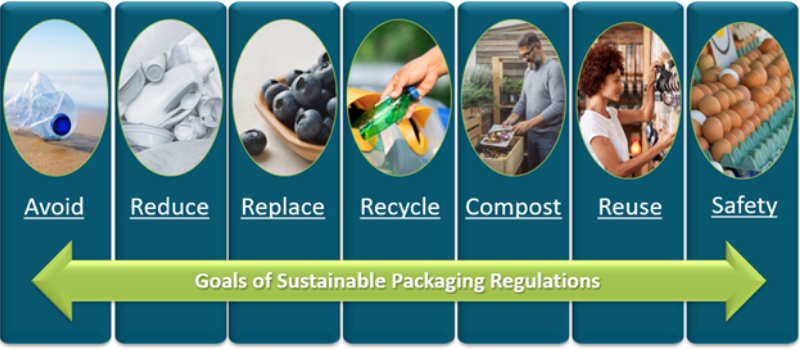The environmentally conscious consumer is on the rise, a legally binding UN treaty on plastic pollution is under way: Are you on top of the complex and varying food packaging regulations around the world?
By Kasey Cruz and Eva Chappell
Global plastic production reaches approximately 430 million metric tons annually, however, only 10% of this material is recycled, while the remainder is incinerated, ends up in landfills, or in the environment. The pressing need to reduce this waste has incentivized countries to act. Interest in sustainable packaging for food and beverage products has exploded in recent years, with numerous countries enacting regulations to make the packaging sector more circular, keep waste out of landfills, and reduce the use of fossil fuel-based packaging.
Achieving these goals, however, is particularly challenging, as food packaging must also comply with strict food safety regulations to avoid food contamination with substances harmful to human health. In a series of short articles, we will take a look at a few cross-sections of this regulatory area, highlighting how this evolving landscape might impact agriculture, food, and beverage exporters. This first installment sets the table by summarizing the wide array of regulatory approaches a country might take to become more sustainable in the food and beverage packaging sector. Our later articles will then zoom in – first on one market (Canada) and the mix of tools that comprise its comprehensive approach to packaging sustainability; and then on one specific policy objective and the variety of regulatory responses that different countries are turning to.
While the variety of sustainable packaging regulations we see in our daily monitoring is vast, they can be organized into 7 common policy pathways to greater sustainability:
- Avoid plastic packaging
- Reduce excessive packaging
- Replace packaging materials with more environmentally friendly alternatives
- Recycle packaging
- Compost packaging and labels
- Reuse packaging
- Safety requirements for recycled materials

The challenge for food and beverages businesses is that countries can choose from a wide variety of policy instruments to achieve their sustainability goals. For example, countries:
- Often notify bans on single-use plastics and disposable foodservice items but differ in their definition of “single-use plastics” and which specific disposable items are prohibited.
- May counter-intuitively ban biodegradable alternatives to plastic disposables to prevent them from ending up in landfills due to lack of facilities that can compost biodegradable single-use items.
- Place limits on “excessive” packaging, variously defined by the number of layers or the amount of empty space within the packaging.
- Ban specific types of plastics deemed “hard-to-recycle”.
- Regulate that packaging must transition to different, more sustainable materials.
- Increasingly require varying levels of recycled content in plastic packaging. Governments may or may not exempt food and beverage products due to food safety concerns, or may require packaging to undergo an authorization process before placement on the market.
- Require participation in deposit-return or extended producer responsibility (EPR) schemes, with variations in the responsible parties and their roles in item collection, reporting, etc.
- Set varying labeling requirements for packaged products to provide information on end-of-use disposal. These labeling standards and logos may be set at the national or regional level or even by the administrative bodies of specific EPR schemes.
- Specify “compostability” labeling language, sometimes specifying home- versus industrial-compostability or prohibiting language that implies plastic packaging would fully decompose in the environment.
- Establish regulations for specific products, such as fresh fruit and vegetables or beverages.
The challenge of meeting diverse regulations across markets is compounded by the ongoing evolution of these regulations from first draft to implementation, as governments also face external factors and a shifting environment. The policy response must be refined as legislators and manufacturers gain deeper knowledge, as new materials and technologies emerge, and as the infrastructure for a more circular economy is put in place.
In addition, multilateral pressure is growing and may drive a preference for some policies over others. In February 2022, the UN Environment Assembly took a first step towards aligning national efforts by adopting a resolution to develop an international legally binding instrument on plastic pollution, focusing on a comprehensive approach to address the full life cycle of plastic. In September 2023, the UN released the Plastic Treaty’s “Zero Draft”, a guide for the upcoming sessions of the intergovernmental negotiation committee as they work to complete the first draft (read more about the “Zero Draft” here). The third session concluded in November 2023 with an agreed starting point for negotiations at the fourth session, which will take place in April 2024 in Ottawa, Canada. At that session, members are hoping to further refine the text, intending to agree on the final text at the fifth and final session in November 2024 in South Korea. The treaty that is ultimately adopted may bring some element of harmonization but could also spark another wave of regulatory changes in specific markets, to which companies will have to adapt.
Need an efficient way to remain informed of developments early and accurately? Subscribing to the BCI Monitor will keep you up to date at each step as countries around the world adopt or amend their packaging and labeling regulations.
For more on global export news, insights and information please visit Bryant Christie Inc’s website, sign up for our e-newsletter and follow us on LinkedIn and Twitter.
